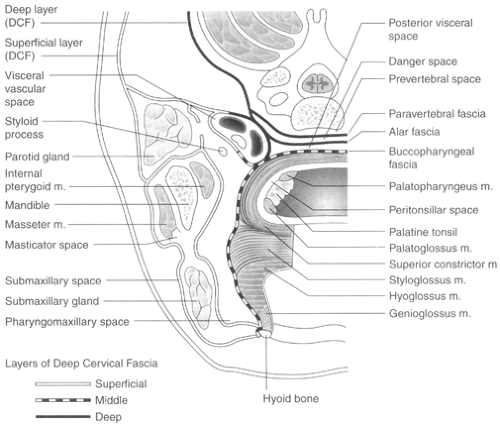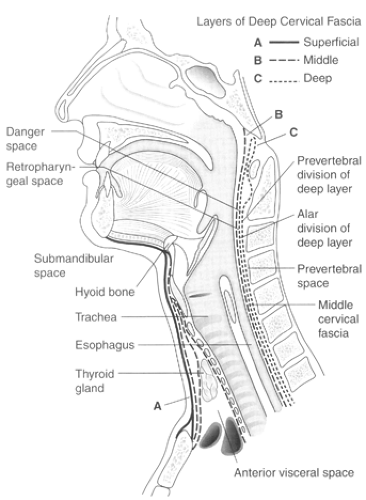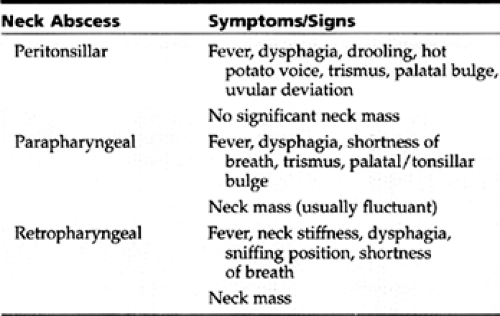Suppurative Complications of Pharyngitis and Neck Masses
Darsit K. Shah MD
PART 1 Suppurative Complications of Pharyngitis
Darsit K. Shah MD
INTRODUCTION
Suppurative complications, although uncommon, are the most frequently seen complications resulting from tonsillitis and pharyngitis. These suppurative sequelae include peritonsillar abscess (PTA), parapharyngeal abscess (PPA), and retropharyngeal space abscess (RPA). Other rare sequelae can occur but are beyond the scope of this chapter.
ANATOMY, PHYSIOLOGY, AND PATHOLOGY
The palatine tonsil is situated between the tongue base inferiorly, the superior constrictor laterally, and the palate superiorly. A tight fibrous capsule surrounds the tonsil in its entirety except at its palatal interface. Here, approximately 20 to 30 mucous glands, named Weber’s glands, lubricate the tonsil and create a potential communication between the tonsil and palate. This potential area is called the peritonsillar space (Fig. 35-1).
 Figure 35-1 Axial section through the neck demonstrating the various deep neck spaces. (Adapted from Bailey B: Principles of Otolaryngology—Head and Neck Surgery, p. 827.) |
The parapharyngeal space (PPS) extends from the skull base to the hyoid bone and is surrounded by the pharynx and vertebral bodies. It is mainly hidden in the retromandibular area. It does communicate posteriorly with the retropharyngeal space (RPS). The RPS is the most dangerous space in the neck because it can extend from the skull base to the sacrum. It is essentially devoid of any important anatomic structures outside of an abundance of lymph nodes in children.
Peritonsillar abscess develops through two potential mechanisms. The first entails direct spread of infection from the tonsil through the capsular dehiscence at its superior pole into the palate, with subsequent suppuration. The second mechanism entails suppuration of Weber’s mucous glands present in the palate adjacent to the tonsil, resulting essentially in a salivary abscess. PPA or RPA, however, rarely result from direct spread of infection. The more likely scenario in the face of tonsillitis is the development of nodal adenitis with suppuration within the node, leading to abscess formation.
EPIDEMIOLOGY
The most common cervical space infection is PTA. Its incidence is approximately 30/100,000 or about 45,000 cases per year (Kitirat et al., 1995). The occurrence of PPA or RPA is less common, with ill-defined incidence.
HISTORY AND PHYSICAL EXAMINATION
Typically, children with PTA present with severe odynophagia or painful swallowing. They usually can only tolerate liquids and many times not even their own saliva. In addition, otalgia and trismus are also frequent. Examination demonstrates a toxic patient with a high fever.
• Clinical Pearl
The combination of hot potato voice due to soft palate edema, drooling, trismus, and uvular deviation is extremely suggestive of a diagnosis of PTA (Table 35-1).
Both PPA and RPA are associated with suppurative neck masses. Children with PPA appear toxic with a high fever and have dysphagia, trismus, and a muffled voice with varying degrees of airway symptoms. Physical examination demonstrates a palatal bulge and most importantly a high cervical neck mass obscuring visualization and palpation of the mandibular angle. In addition, when airway impingement is present, children may assume a sniffing posture to maximize air exchange. Because RPA is usually an extension from a lower suppurative adenitis, the classic clinical findings include a neck mass, fever, and some degree of upper airway obstruction, leading to the sniffing position and some shortness of breath.
If incompletely or inadequately treated, PTA, RPA, and PPA have potential serious and life-threatening sequelae. These include airway obstruction, jugular vein thrombosis, carotid artery rupture, sepsis, and mediastinitis.
DIAGNOSTIC CRITERIA
The diagnosis of PTA usually is established on the basis of the classic findings on physical examination as mentioned previously. The diagnosis of PPA or RPA may be suspected on clinical grounds by the presence of a tender neck mass in association with systemic toxicity and some signs of upper airway embarrassment, such as shortness of breath and the “sniffing position.” Imaging studies are needed to confirm the diagnosis of PPA or RPA.
Various benign and malignant disorders can simulate abscess occurrence within the RPS or PPS. The differential
diagnosis should include infected congenital cyst, lymphoma, rhabdomyosarcoma, or granulomatous disease (Nicklaus & Kelley, 1996). When the clinical scenario is atypical, these other disorders should be considered in the management of the child with RPA or PPA.
diagnosis should include infected congenital cyst, lymphoma, rhabdomyosarcoma, or granulomatous disease (Nicklaus & Kelley, 1996). When the clinical scenario is atypical, these other disorders should be considered in the management of the child with RPA or PPA.
DIAGNOSTIC STUDIES
Before the advent of computed tomography (CT) scanning, only plain AP and lateral neck x-rays were used to assist in diagnosing neck abscesses. Lateral neck films, in cases of RPA, demonstrated RPS of greater than 7 mm at C2 and 14 mm at C6. Other nonsuppurative processes, such as adenitis, could give the same findings. For this reason, when RPA or PPA is suspected, children should undergo a CT scan with contrast. Typical findings when a neck abscess is present include low attenuation areas with ring enhancement. Providers should pay particular attention to the vascular structures and mediastinum to exclude venous thrombosis and mediastinitis.
No purulence is found in 5% to 10% of neck explorations, even with the classic findings on CT scan. This implies that necrotic lymph nodes can occassionally give the same image findings as an abscess. Despite this occassional false-positive, CT scanning has revolutionized the management of the child with a suspected neck abscess (Lazor, 1994).
MANAGEMENT
Multidisciplinary consultation from the primary care practitioner, otolaryngologist, and radiologist is essential in the management of a potential PTA, RPA, or PPA. Initial assessment of a child should exclude imminent or potentially imminent airway obstruction. Further workup and intervention can proceed when the airway has been stabilized.
When a diagnosis of PTA, RPA, or PPA has been confirmed on clinical and radiographic grounds, the provider should obtain a CBC and blood and throat cultures and start the child on broad-spectrum antibiotics with anaerobic coverage.
The bacteriology of neck abscess is usually polymicrobial, with GABHS and Staphylococcus aureus being the most common
organisms. Unfortunately, there is a high incidence of beta-lactamase production. Bacteriodes species, an anaerobic organism, is frequently present concomitantly (Kitirat et al., 1995). Because of these factors, broad-spectrum coverage is necessary in the treatment of neck abscesses in children. Providers should select drugs that combine excellent gram-positive coverage for staphylococci and streptococci with anaerobic coverage. Examples include ampicillin (Unasyn) or a combination of clindamycin or vancomycin and a third-generation cephalosporin.
organisms. Unfortunately, there is a high incidence of beta-lactamase production. Bacteriodes species, an anaerobic organism, is frequently present concomitantly (Kitirat et al., 1995). Because of these factors, broad-spectrum coverage is necessary in the treatment of neck abscesses in children. Providers should select drugs that combine excellent gram-positive coverage for staphylococci and streptococci with anaerobic coverage. Examples include ampicillin (Unasyn) or a combination of clindamycin or vancomycin and a third-generation cephalosporin.
 Figure 35-2 Sagittal section of the neck demonstrating the various spaces between the pharynx and vertebrae. (Adapted from Bailey B: Principles of Otolaryngology—Head and Neck Surgery, p. 827.) |
Traditional teaching has recommended external incision and drainage for all cases of RPA or PPA and internal incision and drainage for all cases of PTA. In select cases, however, other options are available, including treatment with intravenous antibiotics alone, needle aspiration, or transoral drainage.
An external surgical incision and drainage should be performed in all cases in which airway obstruction is present, the child has failed to improve on 24 hours of intravenous antibiotics, or other neck complications accompany the abscess (Gidley & Ghorayeb, 1997).

Full access? Get Clinical Tree







